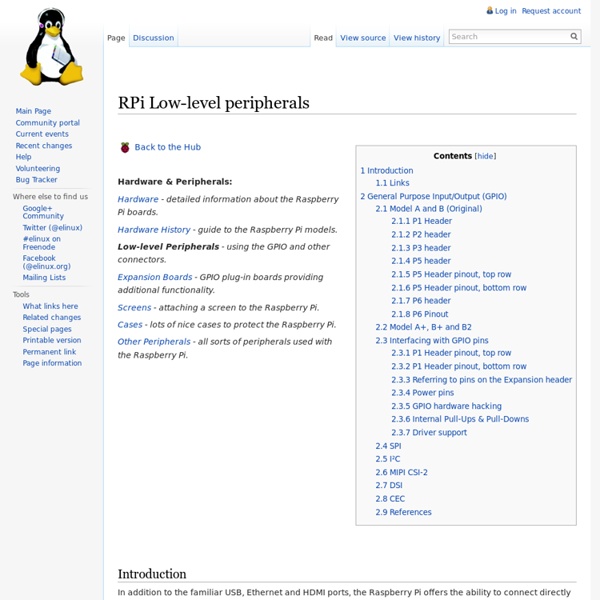Expansion Boards - Rasberry Pi
Back to the Hub Hardware & Peripherals: Hardware - detailed information about the Raspberry Pi boards. Hardware History - guide to the Raspberry Pi models.
Creating a LAMP server (web server - Linux Apache Mysql PHP) on the Raspberry Pi - Linux tutorial from PenguinTutor
This provides details of how to configure a Raspberry Pi as a webserver. This is similar to the guide to using Xubuntu as a LAMP webserver, but adds some of the things that need to be handled differently for the Raspberry Pi. It is termed a LAMP server which is one of the most common configuration for webservers which standard for: Linux – operating system Apache – webserver (http) software Mysql – database server PHP or Perl – programming languages This setup is probably overkill for most uses of the Raspberry Pi, but it is the setup that most users will be familiar with and is a good way to learn about setting up a webserver. I’ll be looking at setting up a lightweight setup in future. All this configuration is done at the command line.
bcm2835: C library for Broadcom BCM 2835 as used in Raspberry Pi
This is a C library for Raspberry Pi (RPi). It provides access to GPIO and other IO functions on the Broadcom BCM 2835 chip, as used in the RaspberryPi, allowing access to the GPIO pins on the 26 pin IDE plug on the RPi board so you can control and interface with various external devices. It provides functions for reading digital inputs and setting digital outputs, using SPI and I2C, and for accessing the system timers. Pin event detection is supported by polling (interrupts are not supported).
Projects - Rasberry Pi
Back to the Hub. Community Pages: Tutorials - a list of tutorials.
New Raspberry Pi development vm version 0.2 « Executing Gummiworms
[update (11/3/12): This version is now out of date. Please use v0.8 the torrent of which is at The readme and the sha1 ] [update: There is a tiny little buglet in the vm that slipped passed me as it didn't crop up when I was testing that yum worked as I didn't install a library that needed to go in the top level of the rootfs.
Project - RaspyFi - Voyage mpd on Raspberry Pi - RaspyFi Project
Dear beloved RaspyFi Users RaspyFi has evolved into Which is compatible with Raspberry Pi, Udoo, Cubox and Beaglebone Black. And brings lots of new, exciting features. RaspyFi website will remain available for archive references, every new activity will be on
Rpi Software
Back to the Hub. Software & Distributions: Software - an overview. Distributions - operating systems and development environments for the Raspberry Pi. Kernel Compilation - advice on compiling a kernel. Performance - measures of the Raspberry Pi's performance.
GPS Display Device
Here are some other old small projects. These are probably from my high school days. Some are from my university days.
Passwordless SSH Using Shared Keys
This is something I use quite often to ease automated (ie, scripted) jobs that are run on a host that needs to connect to another host via SSH/SCP. Just an aside, my favorite alternative to using shared keys for (faux) passwordless connections is an expect script that "expects" a password prompt, which expect will hand back to the host. But that approach is almost always more difficult, requires an understanding of the expect language and is generally less secure. So, below is one method of implementing shared key authentication for passwordless SSH connections. Just tell me how to do it already! OK :-) For the purposes of this example, I'll refer to the host we're connecting from as host1 and the host we're connecting to (without a password) as host2 Generate a shared key on host1 (the shared key will be /home/user/.ssh/id_rsa.pub)
Hardware Basic Setup - Rasberry Pi
Back to the Hub Getting Started: Buying Guide - for advice on buying the Raspberry Pi. SD Card Setup - for information on how to prepare the SD Card used to boot your Raspberry Pi.
RPi VerifiedPeripherals
Back to the Hub Hardware & Peripherals: Hardware - detailed information about the Raspberry Pi boards. Hardware History - guide to the Raspberry Pi models.
Raspberry Pi - run program at start-up
Anyway, I wanted to get my Raspberry Pi to start no-ip dynamic dns service when it started-up, so I wouldn't have to remember to start it every time it was powered up. For details on how to install no-ip on the Pi, see this post. There are loads of ways of running a command at start-up in Linux but my favoured approach is to create an initialisation script in /etc/init.d and register it using update-rc.d. This way the application is started and stopped automatically when the system boots / shutdowns.



